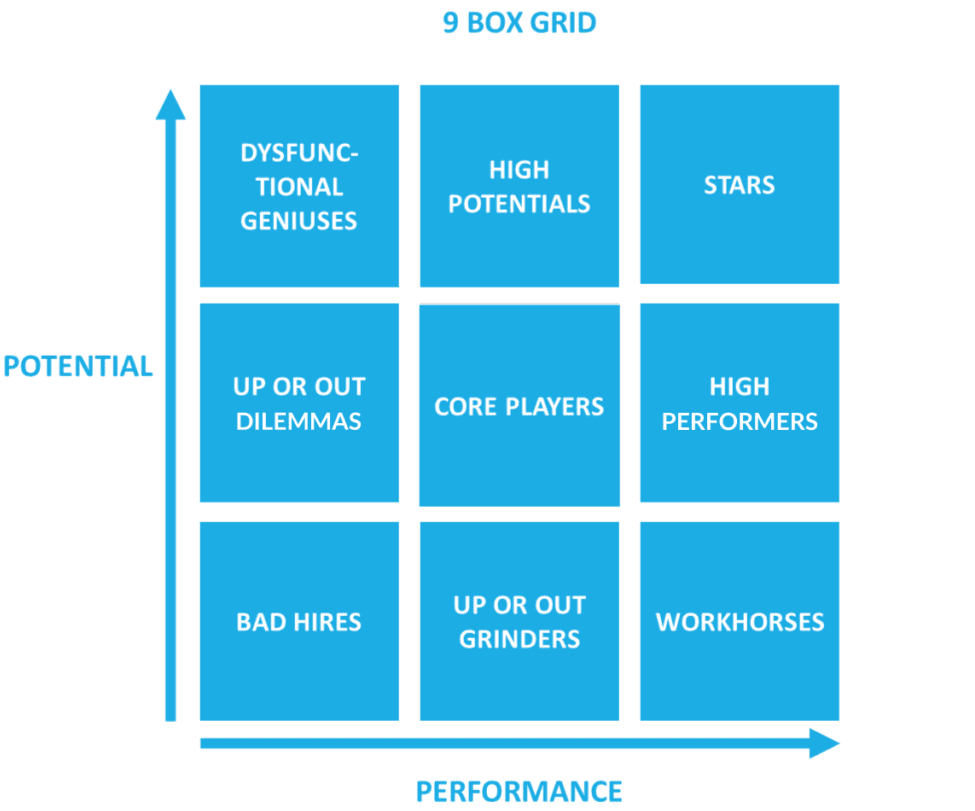The 9 box grid is one of the most well-known performance assessment tools. Companies use it to discover future leaders and those employees with high potential—think succession planning. The 9 box grid talent management tool is often used with data gleaned from performance reviews or other types of talent assessments. And while it may be an industry standard, HR administrators and managers should take a minute to review the potential and pitfalls of this performance assessment tool.
What is a 9 box grid?
The 9 box grid is used to evaluate a company’s talent pool on their potential and performance. The vertical axis indicates potential and the horizontal axis performance. The higher the boxes, the more potential for growth and the farther right the boxes go, the best performance reviews. Employees who land in the bottom left grid, are your lowest performers with the least growth potential. Those who land in the top right grid, your highest performers with the most potential. Employees will fall in all different areas of this grid. You may have high performers that don’t feel the need to grow from their current position, and that’s ok. It’s not realistic to have all superstars, steady Eddies are a great resource too, but your lowest performers (the dreaded bottom left spot) are probably a bad hire.

Typically, the 9-box grid is used in succession planning to evaluate current talent and identify potential leaders. When leadership performance and potential are assessed and plotted on the graph, individuals in the upper right quadrant are identified as high-potential candidates for succession, while those in the lower-left area may need to be reassigned or removed from the organization.
How to Create a 9 Box Grid
Creating your own 9-box grid involves assessing each employee’s performance, potential and then bringing it all together.
Assessing Performance
Performance boxes go from low, to moderate and then high. Using your performance management system, managers can take the information gleaned and score employees based on this scale. HR Analytics proposes this structure:
- Low performance. Employee does not match the requirements of their job and fails their individual targets.
- Moderate performance. Employee partially matches the requirements of their job and their individual targets.
- High performance. Employee fully meets the requirements of their job and their individual targets.
Using this structure relies on a strong job description and how your employee meets the requirements of the position. Other organizations prefer to assess performance on other factors, such as meeting personal goals, working with team members and results of 360-degree feedback. Keep in mind with only three points—low, medium and high—there’s not a lot of wiggle-room between low and high performers. Managers may scale more employees as moderate when they should be low.
Assessing Potential
The next step is to assess potential, which is scored in the same way as performance—low, medium and high. But instead of simply tracking performance, assessing potential takes the performance review information and managers interpret it to determine whether employees are currently working at their full potential, could be developed in their current role or eligible for promotion.
HR Analytics uses this example:
- Low potential. Employee is working at full potential and is not expected to improve, either because they are at maximum capacity or because of a lack of motivation.
- Moderate potential. Employee has the potential to further develop within their current role. This can be in terms of performance, but also in terms of expertise.
- High potential. Employee is eligible for promotion, either immediately, or within two to three years.
Assessing potential is inherently different from assessing performance, even if the process is the same. A low or moderate performer might require more training, need clearer objectives or just might not be suitable for the position. Potential speaks more to the employee’s upward trajectory with the company. Employees labeled with low potential might already be working at maximum capacity, which is what is required for their current positions. This doesn’t mean they’re a bad hire, it just means these employees probably aren’t going to be future members of your management team. On the other hand, if an employee is a low or moderate employee but has high potential, experience gained from development and goal setting could put them on the promotion track in two to three years.
Putting it all Together
Once both performance and potential are assessed, they’re both plotted on the 9 box grid. The talent matrix gives managers and HR a clear view of where each of their employees stands. The best part is that any type of performance evaluation techniques can be used to assess employees’ performance and potential.
What the 9 Box Grid Quadrants Mean
The benefit of using a 9 box grid is that once your employees are plotted, you can quickly see where they currently stand. If all your employees are in the bottom row, tasks may get completed but future growth is limited. On the other hand, if many of your employees are in the top right, they might start looking for positions elsewhere if you’re not fulfilling their career goals.
| High Potential | Diamond in the Rough:
These employees could be awesome but are experiencing problems. |
High Potential:
Good performer that could easily go to the next level. |
Superstars:
Always performs well, big picture thinker and problem solver. |
| Moderate Potential | On the Fence:
Needs development or coaching to progress. |
Solid Players:
Could be given more responsibilities but may need people management training. |
High Performers:
These employees always perform well but may need to set strategic goals. |
| Low Potential | Bad Hires:
Reassign, demote or terminate. |
Backups:
Good performer but may have reached career potential. |
Workhorses:
Great at their job but no desire to expand their skill sets. |
| Under Performer | Moderate Performer | High Performer |
Employers can look at each of these quadrants to determine what action steps need to be taken.
For employees with low potential, set up coaching sessions that help them become more innovative and/or improve communication and delegation skills. Medium potential employees might require help setting goals that are more strategic and focus on the big picture. High potential employees need to be prepared to take their career to the next level.
Action steps for employees with low performance could include clarifying job requirements, providing additional training or transferring to roles better suited for their aptitude and skills. Managers also need to determine what roadblocks exist that are impacting performance.
Using the 9 Box Talent Matrix for Succession Planning
The 9 box talent matrix easily identifies top performers so employers can get a realistic view of their bench strength. The biggest benefit to using this matrix for succession is that employers think beyond performance but include potential in decision making. For example, consider your diamond in the rough employees; these employees are among those with the highest potential but because they’re low performers, simply relying on performance reviews wouldn’t illustrate this fact.
Using a 9 box talent matrix, managers can see more of the big picture when determining which individuals to promote by seeing employee ratings on a variety of concrete metrics and forward-thinking attributes.
Beware of these Common 9 Box Grid Pitfalls
While the 9 box grid has its benefits, it also has some pitfalls.
It is subjective.
It is up to the manager as to where an employee will land. While the assessments are based on performance evaluations, determining potential might vary from person-to-person. One manager might see an employee as having low potential, while another might see moderate potential. Any time you measure or evaluate performance, many tools should be used.
It doesn’t evaluate aptitude.
Just because an employee is a high performer with moderate to high potential, doesn’t mean she or he can manage employees. A manager needs to be able to not only problem solve, but manage stress, influence others, delegate and have self-confidence.
It is not transparent.
Probably the most serious pitfall is the lack of transparency the 9-box grid provides. Think back to middle school; if you found a list of names of kids who were “cool” or “not cool,” how would you feel if your name was listed under “not cool”? Essentially the matrix is the same. An employee who finds out they’re classified as having low potential would be even less engaged at work, even if they’re high performers.
It doesn’t offer “gray” areas.
Not every employee in every situation falls neatly into one of nine boxes. Additional discussions need to be had before promoting or firing an employee. Maybe those with top potential are simply favorites of management. Or, maybe low performers didn’t get onboarded and trained properly. It is hard to show potential when you’re struggling to do your job. Inadvertently, those employees that land in the lower left of the 9 box grid won’t receive as much attention for improvement as those in the upper right.
While a 9 box talent matrix can provide a picture, it may not always tell the entire story. Plus, if you’re not following through with actions, all the work of assessing and plotting employees is a waste. The matrix needs to be used as a part of your promotion decision-making, not the end-all process.
Arcoro’s Performance Management and Succession Planning solutions offer companies a wide variety of talent management tools, so you have multiple ways to review performance and correctly identify future leaders. The Performance Management module allows managers to motivate employees with regular, actionable feedback, easily monitor both qualitative and quantitative goals and get 360-degree feedback.
The Succession Planning module works with Performance Management to aggregate its data to identify the competencies of standout employees. While it offers a 9 box talent matrix, it also helps to identify gaps and create actionable development plans.

Schedule a demo to see how these two modules seamlessly work together to identify your company’s top talent.




